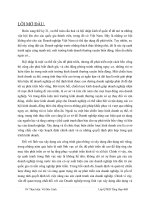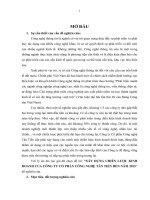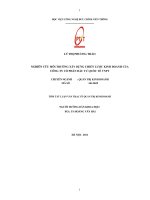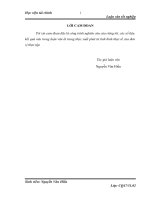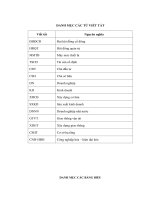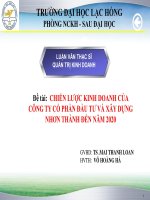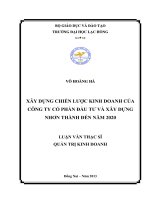Xây dựng chiến lược kinh doanh ở công ty cổ phần đầu tư xây lắp dầu khí hòa bình pvchb trong giai đoạn 2019 2023
Bạn đang xem bản rút gọn của tài liệu. Xem và tải ngay bản đầy đủ của tài liệu tại đây (1.3 MB, 92 trang )
ĐẠI HỌC QUỐC GIA HÀ NỘI
KHOA QUẢN TRỊ VÀ KINH DOANH
---------------------
TRẦN MINH VƯƠNG
BUILDING BUSINESS STRATEGY AT HOA BINH
PETROLEUM CONSTRUCTION AND INVESTMENT
JOINT STOCK COMPANY (PVCHB) FOR 2019-2013
XÂY DỰNG CHIẾN LƯỢC KINH DOANH Ở CÔNG TY
CỔ PHẦN ĐẦU TỪ XÂY LẮP DẦU KHÍ HỊA BÌNH - PVCHB
TRONG GIAI ĐOẠN 2019-2023
LUẬN VĂN THẠC SĨ QUẢN TRỊ KINH DOANH
HÀ NỘI - 2020
ĐẠI HỌC QUỐC GIA HÀ NỘI
KHOA QUẢN TRỊ VÀ KINH DOANH
---------------------
TRẦN MINH VƯƠNG
BUILDING BUSINESS STRATEGY AT HOA BINH
PETROLEUM CONSTRUCTION AND INVESTMENT
JOINT STOCK COMPANY (PVCHB) FOR 2019-2013
XÂY DỰNG CHIẾN LƯỢC KINH DOANH Ở CÔNG TY
CỔ PHẦN ĐẦU TỪ XÂY LẮP DẦU KHÍ HỊA BÌNH - PVCHB
TRONG GIAI ĐOẠN 2019-2023
Chun ngành: Quản trị kinh doanh
Mã số: 60 34 01 02
LUẬN VĂN THẠC SĨ QUẢN TRỊ KINH DOANH
NGƯỜI HƯỚNG DẪN KHOA HỌC: TS. HOÀNG ANH TUẤN
HÀ NỘI - 2020
UNDERTAKING
I pledge that the dissertation "Building business strategy at Hoa Binh Petroleum
Construction Investment Joint Stock Company - PVCHB in period 2019-2023" is
my own research. All content and results of the thesis are true and not published in
any other study. Data and figure are used in the thesis are correct and all sources
are stated.
Hanoi, July 1st, 2019
AUTHOR
TRAN MINH VUONG
CATEGORY
UNDERTAKING
LIST OF ACRONYMS
PREAMBLE ....................................................................................................................... 1
1. Subject name ................................................................................................................. 1
2. Reason for choosing topic ............................................................................................ 1
3. Objectives of the study ................................................................................................... 3
4. Object and scope of the study......................................................................................... 3
5. Research methods ........................................................................................................... 3
6. Source of research data................................................................................................ 3
7. Limitations of the thesis ............................................................................................... 3
8. The composition of the thesis ...................................................................................... 3
CHAPTER 1 THE RATIONALE FOR DEVELOPING THE BUSINESS
STRATEGY OF THE ENTERPRISE ........................................................................... 5
1. BUSINESS STRATEGY - DEFINITION, ROLE, PROPERTY AND TASKS ............ 5
1.1. Define .......................................................................................................................... 5
1.2. The role of business strategy .................................................................................... 5
1.3. Basic characteristics of business strategy .............................................................. 6
2.1. Vision and mission ...................................................................................................... 6
2.1.1. Vision..................................................................................................................... 7
2.1.2. Mission .................................................................................................................. 7
2.2. Environmental analysis ............................................................................................... 8
2.2.1. Analysis of external environment .......................................................................... 8
2.2.1.1. Macro-environmental analysis ........................................................................... 8
2.2.1.2. Sectoral Environmental Analysis ..................................................................... 11
2.2.2. Internal environmental analysis ........................................................................... 15
2.2.3. Value Chain ......................................................................................................... 17
2.2.4. Identify outstanding competencies and sustainable competitive advantage ....... 19
2.3. Strategic options ........................................................................................................ 20
3. STRATEGIC ANALYSIS TOOLS .......................................................................... 20
3.1. SWOT analysis matrix .............................................................................................. 20
3.2. GREAT model ........................................................................................................... 22
4. BASIC TRADING STRATEGY ............................................................................... 22
4.1. Strategic basis ............................................................................................................ 22
4.2. Types of general competition strategies .................................................................... 24
4.2.2. Differentiation strategies ..................................................................................... 25
4.2.4. Incorporate common strategies............................................................................ 26
CHAPTER II ANALYSIS OF BUSINESS ENVIRONMENT OF HOA BINH
PETROLEUM
CONSTRUCTION
AND
INVESTMENT
JOINT
STOCK
COMPANY (PVCHB) ................................................................................................... 28
1. GENERAL INTRODUCTION ................................................................................. 28
1.1. General information................................................................................................... 28
1.2. The formation and development of PVCHB ............................................................. 29
1.3. Organizational structure and main business lines ..................................................... 31
1.4. Main business lines.................................................................................................... 32
1.5. Characteristics of the oil and gas construction sector ............................................... 32
2. ANALYSIS OF FACTORS IMPROVING PVCHB ............................................... 33
2.1. Macro Elements - PEST Model................................................................................. 33
2.1.1. Political and legal factors (P) .............................................................................. 33
2.1.2. Economic factor (E) ............................................................................................ 34
2.1.3. Social cultural factor (S) ...................................................................................... 37
2.1.4. Technological factor (T) ...................................................................................... 37
2.2. Sectoral Environmental Analysis. ............................................................................. 39
2.2.1. Current competitors ............................................................................................. 40
2.2.2. Potential competitors. .......................................................................................... 42
2.2.3. The power of the customer .................................................................................. 43
2.2.4. Power of the supplier. .......................................................................................... 44
2.2.5. Threat of alternative products or services ........................................................... 45
2.2.6. Evaluating opportunities and challenges ............................................................. 45
2.3. Analyze the internal factors. ...................................................................................... 46
2.3.1. Analysis of resources. .......................................................................................... 46
2.3.2. Assess the strengths and weaknesses of PVCHB. ............................................... 58
2.3.4. Synthesis assesses strengths and weaknesses of PVCHB ................................... 63
CHAPTER III SELECTION OF TRADING STRATEGIES AND SOLUTIONS
FOR THE IMPLEMENTATION OF THE STRATEGY FOR 2019 - 2023 ............ 65
1. GENERAL OBJECTIVES OF PVCHB .................................................................. 65
1.1. Vision and mission .................................................................................................... 65
1.2. General objective to 2023:......................................................................................... 65
2. OPTIONS OF PVCHB TRADING STRATEGY ................................................... 67
3.1. GROUP IMPLEMENTATION STRATEGY 1 ..................................................................... 73
3.1.1. Solutions on science and technology................................................................... 73
3.1.2. Solutions on Organization and management and development of human
resources 73
3.2. Strategy implementation team 2. ............................................................................... 79
4. SOME LIMITATIONS AND CONCLUSIONS ..................................................... 82
CONCLUDE ................................................................................................................... 83
REFERENCES
LIST OF ACRONYMS
ACRONYM
MEANING
CPI
Consumer Price Index
FDI
Foreign Direct Investment
GDP
Gross Domestic Product
KPI’s
Key performance Indicators
ODA
Official development assistance
PVC
Petrovietnam Construction Joint Stock Corporation
Hoa Binh Petroleum Construction and Investment Joint Stock
PVCHB
Company
Vinaconex-PVC
Construction
Investment
Joint
Stock
PVC-Vinaconex
Company
PVNC
PetroVietnam Nghe An Construction Joint Stock Company
PVC-HN
Ha Noi Petroleum Construction Joint Stock Company
LIST OF DIAGRAMS AND TABLES
Diagram 1-1: The process of building a business strategy ......................................... 7
Diagram 1-2: Model of the competitive force of M.Porter ...................................... 11
Diagram 1- 3: Diagram chuỗi giá trị (value chain): ................................................. 18
Table 1- 2: Process of recognition of sustainable competitive advantage................ 19
Diagram 2- 1: Organizational structure of PVCHB ................................................. 31
Table 2 - 1: Vietnam’s GDP in the period 2008-2017 ............................................. 35
Table 2-2: Some business indicators of PVCHB compared with some competitors
in 2018 ...................................................................................................................... 41
Chart 2-2: Market share of construction companies in 2018. .................................. 42
Table 2-2: Opportunities and challenges of PVCHB ............................................... 45
Table 2- 3: Results of implementation of some operational indicators for the period
2016 - 2018 ............................................................................................................... 47
Table 2-5: Business results of PVCHB .................................................................... 51
Table 2-6: Statistics table of construction equipment. ............................................. 54
Table 2- 7: Summarize the evaluation results of the external expert group ............. 61
Table 2-8: Summarize the results of the internal review team ................................. 62
Table 2- 9: Analyzes table strengths and weaknesses of PVCHB ........................... 64
Table 3-1: SWOT analysis matrix ........................................................................... 70
Table 3-2: Choosing the optimal strategy - GREAT model ..................................... 72
1
PREAMBLE
1. Subject name
Thesis title "Building Business Strategy in Hoa Binh Petroleum Construction and
Investment Joint Stock Company (PVCHB) for 2019-2023".
2. Reason for choosing topic
After opening up and integrating into the economy, Vietnam has achieved
some important achievements, the basic overview maintains macroeconomic
stability, maintaining a relatively high economic growth rate, the size of the
economy increased. To achieve the overall objective of economic development in
the five years of 2018-2022, to achieve rapid and sustainable economic
development and create a foundation for the country to become a modern
industrial country by 2030. The average economic growth rate of 2018-2022 is
expected to be 7.0-7.5%. In which, the average value added of industry and
construction increased by 7.8-8%, and the construction industry structure
accounted for 42%. In the strategy, objectives and tasks of economic development
in the next 5 years, we see the very important role of the industry - construction
with the structure of 42%, which is one of the key areas for deciding to the success
of the plan.
To gradually realize the position and leading role of the industry construction contributes to the common development; Every organization,
economic sector, economic groups and enterprises must have strategies in line
with the trend of integration and the development of the market. Due to the
increasing compettion of current and potential competitors, the company’s
business activities show signs of moving sideways and cannot develop. Starting
out from that practice, building a business strategy is essential for every business.
It helps enterprises have clear business direction and objectives, directing
departments and individuals to the common objectives of the enterprise, avoiding
the local situation, dispersing resources will weaken the business. Today's
business environment is changing so rapidly, global competition requires
businesses to be proactive, creative to adapt to change. In order to develop fast,
1
sustainable and successful enterprises, it is necessary to pay attention to investing
their time and effort in managing and developing their business development
strategies.
Hoa Binh Petroleum Construction and Investment Joint Stock Company
(PVCHB) was established in 2007 and is a member company of Petrovietnam
Construction Joint Stock Corporation (PVC). The key activities are: Investment in
construction, civil and industrial construction, financial investment, real estate,
industrial production, building materials, real estate trading floors .... The
company operates in the whole country with emphasis on the northern market.
Some of the business fields of the Company have specific characteristics such as
construction works in the oil and gas industry, technical infrastructure works, real
estate investment projects ... require the binding conditions about strong financial
capacity, ability to raise capital, prestige, responsibility with specialized
management agencies, timely orientations and decisions and strategic vision of
business leaders. Development strategy of PVCHB is planned in terms of time,
space and competitive environment, in which there is cohesion and authenticity
with the common development orientation of PVC are: strong and sustainable,
combining economic development closely linked with environmental protection
and national security, cooperation with domestic and foreign partners, taking full
advantage of being a member of PetroVietnam Vietnam Country (PVC source).
Participated in the study of the MBA program of Hanoi National
University, with knowledge gained and desired to be practiced in the working unit
is PVCHB, PVCHB has a solid foundation, comprehensive development soon
become a brand of investment and construction with prestige, capacity,
competitiveness, breakthrough power and always bring value and high efficiency.
I decided to select the topic "Building business strategy in Hoa Binh Petroleum
Construction and Investment Joint Stock Company (PVCHB) for the period of
2019 - 2023" to study, this subject will be the reference document. This is a very
important and practical way to develop and implement PVCHB's business
strategy.
2
3. Objectives of the study
To formalize the theoretical issues of strategic management;
Develop business strategy for PVCHB;
Identify the strengths and weaknesses to provide solutions to implement the
business strategy of the enterprise in the period 2019-2023;
4. Object and scope of the study
Research subjects: Business Strategy of Hoa Binh Petroleum Construction and
Investment Joint Stock Company PVCHB.
Scope of research: 2019 - 2023.
5. Research methods
Research methods: case studies, qualitative research;
Specific research methods: comparison, analysis and evaluation.
6. Source of research data
Data, documents related to the construction industry, investment;
Data related to PVC;
Report on the performance of PVCHB in the years (2016-2018), available
materials (secondary documents) to consider the scale, structure and trend of the
market.
7. Limitations of the thesis
Limitations on time;
Data sources are incomplete due to the limited research framework;
The scope of research is limited to construction.
Expected results of the thesis
Select and develop a suitable business strategy for PVCHB
Specific solutions and plans to implement solutions in business strategy was built
for PVCHB in the period 2019 - 2023.
8. The composition of the thesis
In addition to the introduction and conclusion, the main content of the topic
consists of 3 chapters:
Chapter I: The rationale for developing the business strategy of the enterprise.
3
Chapter II: Analysis of Business Environment of PVCHB.
Chapter III: Selection of trading strategies and solutions for the implementation of
the strategy for 2019-2023
4
CHAPTER 1
THE RATIONALE FOR DEVELOPING THE BUSINESS STRATEGY OF
THE ENTERPRISE
1. BUSINESS STRATEGY - DEFINITION, ROLE, PROPERTY AND
TASKS
1.1. Define
Business strategy involves the goals of a business, the strategies developed
must help the business achieve its objectives. Business strategy, however, is more
concerned with how a business can compete successfully in a particular market. It
involves strategic decisions about product selection, meeting customer needs,
gaining competitive advantage over competitors, exploiting and creating new
opportunities, etc. Fred R. "Business strategies are the means to achieve long-term
goals."
It can be said that business strategies are the means to help businesses
achieve long-term goals. Business strategy is not intended to outline concrete
ways, but rather the overall program, the most effective means of mobilizing
resources to implement identified goals. Business strategy can be broadly defined
as follows: Business strategy is a series of commitments and actions that a
company uses to gain a competitive edge by exploiting its capabilities. Core in a
given market (P.Rindova & CJFombrun, 2009)
1.2. The role of business strategy
Business strategies help businesses recognize their purpose as a basis for
business activities of the enterprise.
Business strategies help businesses capture and utilize business
opportunities and take proactive measures to address the threats and threats in the
competitive marketplace.
Business strategy contributes to improve the efficiency of the use of
resources, strengthen the competitive position of enterprises to ensure the
sustainable development of enterprises.
Business strategy provides a solid basis for making policies and decisions
5
on production and business in line with market movements.
1.3. Basic characteristics of business strategy
The business strategy clearly defines the basic objectives and business
direction of the enterprise in each period;
Business-oriented strategy for enterprises to develop continuously and
firmly in the constantly changing business environment;
Business strategy to ensure the optimal combination of exploitation and use
of resources of enterprises in the present and future; promote the advantages and
seize the opportunity to win the competitive edge;
Business strategy is reflected in the continuous process;
Business strategy is forward thinking, winning the market;
Business strategies are usually built up over a long period of time (3 years,
5 years, 10 years, etc.).
2. THE PROCESS OF BUILDING THE BUSINESS STRATEGY OF THE
ENTERPRISES
2.1. Vision and mission
The overall business strategy is based on the vision statement of the
business, oriented to the entire operation of the business and therefore strategic in
the long run. The process consists of the following steps:
6
Vision,mission
100
80
60
Analysis
of
external
environment:
1. Macro Analysis
PEST/SLEPT model
2. Micro-analysis
M. Porter model
East
40
Strategy
building and
20 selection
0
SWOT
model
1st Qtr 2nd Qtr 3rd Qtr 4th Qtr
West
Internal
environmental
North
analysis:
Value chain model
Process to recognize
sustainable competitive
advantage
Strengths and weaknesses
Cơ hội và thách thức
Cost leadership strategy
Differentiation strategies
Strategic focus
The organizational
Implement and adjust
Monitoring and
structure is in line with the
strategy
evaluating the
implementation of the
selection strategy
strategy
Diagram 1-1: The process of building a business strategy
(Source: HSB Strategic Management Teaching Guide 2008)
2.1.1. Vision
Vision is understood as follows: "A vision statement is a report about the
position your company expects to achieve. The vision statement outlines your
company's future when they achieve their goals and goals may differ from one
another in terms of length, which may be a brief statement, but may also be a long
paragraph, but must determine the final destination. you "(Source of Vietnam
Learning)
2.1.2. Mission
7
Mission is a statement intended to inform the existence of a business,
which defines the values and rules governing the business and is an essential part
of the strategic planning process.
Missions can vary in length and in terms of business, purpose, and values.
The mission of the company lies in the fact that the company exists in the market,
who you are and what you will bring to your customers and the community.
Decisions in the strategic planning process and in the dominance of the company
must always be in harmony with the statement of mission.
The mission statement is the foundation of the company's vision. Mission
Statement or can motivate employees to convey the goals and values of the
company to customers and the community.
2.2. Environmental analysis
2.2.1. Analysis of external environment
The goal of external environmental analysis is to identify opportunities and
challenges for the enterprise, to analyze how to implement and capture
opportunities from the environment, and to avoid challenges. necessary for the
business.
The scope and contents of environmental analysis include: macroenvironmental analysis (general environment) and micro-environmental analysis,
also known as the sectoral environment.
2.2.1.1. Macro-environmental analysis
Macro environment is the environment within the whole national economy,
which consists of six segments: economy, technology, culture, society,
demography, politics, law and the world. Changes in the macro environment can
have a direct impact on any force in the industry, and therefore may affect relative
forces and on themselves, ultimately altering the attractive of an industry.
Inside:
Political and legal environment (P): Include a system of views, policies of
the State, the legal system, especially laws related to business; The political
8
developments taking place in the country and in the world, factors related to
politics and the law.
The economic environment (E) is a direct and powerful factor affecting the
business performance of enterprises, through changes in macroeconomic variables
as well as the impact of macro economic policies through the regulatory tools of
the State.
The state of the macroeconomic environment determines the health and
prosperity of the economy, which always has an impact on businesses and
industries. Therefore, businesses must study the economic environment to
recognize its changes, trends and implications.
Socio-cultural environment (S): includes socio-cultural factors affecting
human life and behavior, thereby affecting structure of demand, behavior of
shopping, consumer orientation of the customer.
The technological environment (T :) includes technical and technological
factors that determine the birth of new products, the formation of business models,
the means of satisfying demand, affecting competitiveness and business
performance of the business.
Population-natural environment: At present, population is often associated
with development, showing the importance of this factor to the overall
development of society. The aspects of the population-labor environment that
need to be analyzed include:
International environment: The trend of regionalization, globalization has
been developing in the world, many economic relations between countries and
regions have affected many areas of social life. Every business, every industry,
every government must take into account. The rapid development of science and
technology, the rapid advances of information technology, have brought nations
together to form a global trade network. These tremendous fluctuations have a
strong impact on businesses, creating opportunities and challenges in business,
which directly influence and first of all go to strategic management.
9
As such, the main goal of macro-environmental analysis is to identify
changes and expected trends from external environmental factors with
opportunities and challenges to build clear and objective targets to promote better
production and business activities.
Summary of the macro environment analysis in the following table.
Table 1-1: Synthesis of macro-environmental factors.
Legal politics
(P)
- Antitrust Law
- Labor Law
- Tax law
- Education policy and
- Adjusted philosophies
philosophy
- CPI
Economy (E)
- Interest rate
- Personal Savings Rate
- Balance of trade
- Savings of enterprises GDP
- Budget balance
- Environmental concern
- Female labor force
Socio-cultural
(S)
- Moving jobs and career
- Diversify labor
- Attitude towards quality
work
Technology (T)
Natural –
Demographics
environment
Global
environment
favorites
- Change of perception with
product or service
- Focus of private and assisted
- Product innovation
Government on research and
- Apply knowledge
development
- Climate, ecology
- Population
- Ethnic communities
- Age structure
- Income distribution
- geographic distribution
- Important political events
- Global basic market
- New industrial countries
- Differences in institutional
culture
10
In summary, the main goal of macroeconomic analysis is to identify
changes and trends from external environmental factors. The results of external
environmental analysis will help business managers to synthesize real
opportunities and challenges for their business. As a result, business executives
have the means to build and choose a development strategy that is right and
objective.
2.2.1.2. Sectoral Environmental Analysis
A narrow manufacturing or technical-economic sector, including many,
can offer the same or similar products and services that are interchangeable.
The task of the strategists is to analyze and judge the competitive forces within
the industry to identify opportunities and challenges for their business.
Michael E. Porter's Model 5 Forces: Michael E. Porter, Harvard
Business School Strategist Theorist and Practitioner, provides a framework for
executives to identify opportunities and the risk faced by the business in an
industry (Michael E. Porter, Competitive Stratery, New York: Freepress, 1980).
The framework of Michael E. Porter is called the Competitive Force Model, as
shown in the following diagram:
Potential opponents
(Potential Competition)
Power supplier
Businesses and
Customer power
current
competitors
Power supplier
Diagram 1-2: Model of the competitive force of M.Porter
M. Porter pointed out that the stronger the forces, the more limited the
ability of existing companies to increase prices and get higher profits. In the
11
context of Porter, a strong competitive force can be seen as a threat, because it will
reduce profits. The strength of the five forces can change over time, when
conditions change so the competition forces the company to increase its
investment costs in order to differentiate its products and services from the market
or reduce the cost.
Customer power
Customers can be divided into five categories: end consumers; Distributors:
agents, wholesalers; businesses; the organs of the party and the state; international
customers. Customers are the object that the business serves and that determines
the success or failure of the business; because the size of the customer makes up
the size of the market; Therefore, businesses must constantly monitor their
customers and forecast changes in their needs. Enterprises need to capture and
track information about customers to have appropriate business strategy. In terms
of competition, customers often put pressure on the seller when conditions. The
greater the pressure on the customer, the greater the risk to the business. Customer
pressure is usually expressed in the following cases:
Many suppliers are small and medium in the supply chain, while buyers are
few and large. This case the buyer can dominate the supplier.
Customers buy in bulk.
The supply chain depends on the customer with a large percentage of the
total order.
Customers tend to be self-contained.
It's easy and inexpensive to switch to other people's purchases.
Seller's products are less important to buyers.
Clients have full information about the market, demand, prices of suppliers,
the greater their bargaining pressure.
Power Supplier
In order to carry out the production process, enterprises must regularly
contact suppliers of supplies and equipment, labor supply, finance, etc. These
forces often also positively or negatively affect the strategy of the business.
12
However, these forces can only exert pressure on the enterprise in the
following cases:
There are few suppliers.
There are few alternative service products.
When the supplier has the advantage of differentiating the products and
services.
When a business purchases a product, it is not an important customer and a
supplier's priority.
When a vendor has a vertical linking strategy, ie self-contained production.
Pressure from alternative products
Replacement products are the products of competitors in the same industry
or other products of the industry but capable of satisfying the same needs of the
customer. With the explosion of new technologies, alternative products are
increasingly diversified, creating the risk of price competition that reduces the
company's profitability. In today's era, the dangers of substitute products from
other industries often create unpredictability for all businesses.
Potential competitors
Potential competitors include those that are capable of creating competitive
forces in the future. The competitiveness of potential competitors is directly
related to barriers to entry into their industry. There are five main barriers to entry
for each business:
Product differentiation: The trust and loyalty of customers to the image and
brand of the present enterprise, the cost of a differentiated product strategy is very
high and very risky.
Absolute advantage of cost price.
Advantage of scale: the costs of production, distribution, advertising,
services, research will decrease corresponding to the increase in product sales.
Legal regulations: In practice, government regulations create a major
barrier to entry into many industries. Through licensing or special regulations, the
government can control penetration into a sector.
13
Barriers to distribution have been established by existing businesses.
The response of current businesses in the business sector: the speed and
intensity of retaliation of the current rivals will be a major barrier.
Competitive pressure from current rivals
If the weaker the competition, the business has the opportunity to
increase sales prices and make more profits. In contrast, when competitors are
strong, price competition is significant and every price competition hurts
business.
Competition among enterprises in a manufacturing industry generally
includes the following: the competitive structure of the industry, the state of the
industry and the barriers that leave the industry.
Competitive structure of the industry: This structure is based on the data
and distribution capacity of enterprises in the manufacturing sector. Competitive
structure varies from the dispersed industry to the centralized production. The
dispersed sector includes a large number of small and medium enterprises, none of
which hold the dominant position in the industry. Concentration is dominated by a
handful of large businesses, even the only one called monopoly. The nature and
level of competition of the industry is very difficult to analyze and predict.
The demand situation of an industry is another determinant of the intensity
of internal competition. Normally, demand increases, giving enterprises a great
opportunity to expand their operations and reduce demand, leading to strong
competition for enterprises to keep their market share.
Barriers to leave the industry: As the business conditions in the industry
deteriorate, business difficulties forced businesses to consider withdrawing from
the industry; Withdrawal from the industry causes businesses to lose and lose. If
that loss is greater, if the barriers leave the industry, the competition will be more
intense.
The task for executives is to be aware of the opportunities and threats that
the change of the five forces will lead to the development of adaptation strategies.
Furthermore, it is the ability of a company to adopt a strategic choice, shifting the
14
power of one or more competitive forces to its advantage.
In summary, analyzing the external environment is extremely important to
the business. The goal of the analysis is to identify the opportunities and
challenges, on the basis of which rational management decisions. Some important
points are drawn as follows:
A business that responds to market needs, its strategy will be more
effective.
The main causes of growth and degradation are other changes to a large
level in enterprises that are often environmental factors rather than internal ones.
The more a business depends on an environment, the more it needs to focus
on analyzing and judging the environment.
The environment is variable and uncertain, and requires more analysis and
better judgment.
Strategic wise and effective strategists must know themselves (internal
analysis) and know people (external environment analysis).
The final step in organizing value for the external environment is to
evaluate and rank opportunities and challenges.
2.2.2. Internal environmental analysis
Strategists need to understand the internal environment in order to know
the strengths and weaknesses of their organization. This is very important because
it shows the strengths and weaknesses of the business to consider when deciding
to choose business strategy.
In fact, it is not possible to evaluate all the internal factors in the enterprise
because of its huge amount. Therefore, in order to assess the internal environment
of an enterprise, it is necessary to point out the key factors in which their presence
may be representative of the internal performance of the business. These factors
are the value chain of the business and its core competencies.
The production process is the main activity of the enterprise associated
with the creation of products and services. When analyzing the production process
of an enterprise, it is necessary to first assess the production equipment and
15
technologies capable of producing quality products and services. Can they
produce output that meets market demand? If not, how to overcome? Large-scale
production, stable input supply with reasonable price, suitable layout of means of
production, warehouses and yards make great contribution to the production
process. Also consider the use of labor, satellite units, inspection of enterprises.
Financial factor
Financial resources (such as cash, creditworthiness, owner capital ...) are
the most basic resources of an enterprise. Analysis of financial sources based on
economic and financial standards such as profitability on a capital, working
capital, ability to recover capital, cash flow, debt ratio, solvency, share capital,
ability to raise short-term and long-term capital, capital of the company, cost of
capital compared to the industry and competitors, tax issues, relationship with the
owner. Analysis of financial indicators can determine the strengths and
weaknesses of enterprises in terms of investment, finance and dividends.
Factors in organization, administration and governance
This analysis focuses on the following issues: How did the enterprise
conduct its management activities related to the preparation for the strategy
formulation?
Production process elements
How are the formulation processes and the content of the operational
plans?
Is the distribution of resources based on the objectives set?
Does the company have plans to deal with unpredictable situations? How
does the organization motivate employees?
How are job descriptions described?
In terms of monitoring, the analysis will answer questions such as: How
does a company have financial control, sales, production, inventory, inventory? Is
there an effective management control system? What is the quality check? What is
the information system? Is the control system of the enterprise fast and accurate?
...
16
